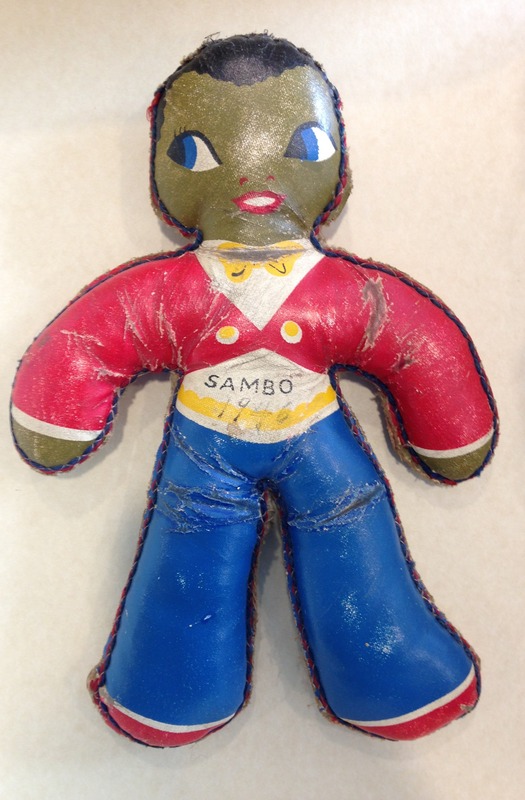This image of a Sambo doll from 1945 is one example of the breadth of representation and popularity that the Sambo character achieved in the 19th and early 20th centuries. Writers and illustrators created thousands of variations of the characters from Helen Bannerman’s 1899 racist children’s book, The Story of Little Black Sambo. For decades, people of all ages and from around the world enjoyed these images and bought merchandise such as toys, ornaments, and dolls that were sold along with the books. This combination of selling sentimental childhood stories with an accompanying doll or toy has proven to be a powerful commercial strategy. This commercial formula, which pairs strong feelings with an object that the child can have and hold, is still very effective today. Public buy-in is massive in everything from Ideal Toy’s merchandising of the Theodore Roosevelt “Teddy’s Bear” to McDonald's Happy Meal toys depicting the latest Disney movie. Many of the items that accompanied the racist Sambo stories and depictions remain valued collectibles today. This long lasting impact can be attributed to the sentimentality held for the children’s narrative and with the feelings of power that come from property ownership in a culture built not just on the ownership of things but also of people.
In "Black Stereotypes as Reflected in Popular Culture, 1880-1920," J. Stanley Lemons reflects on popular culture’s role in manifesting these racist sentiments;
“All these stereotypes were part of the popular culture of America at the turn of the twentieth century. (...) The images were spread and maintained in advertising cards, songs from Tin Pan Alley, phonograph records, children’s books (e.g., Little Black Sambo and Ten Little Niggers), cartoons, magazine ads, valentines, and post-cards (Lemons 102-103).
Racist doll culture was a specific avenue of popular culture in which ownership racism, a continuation of chattel slavery, was easily translated to the younger generations in a socially acceptable manifestation of toy collection. Dolls have the ability to become particularly problematic, as it is typical in their creation to oversimplify the dolls’ features to make them cute, sweet, and baby-like. However, in the case of black dolls, this oversimplification functioned to make them look horrific and especially inhuman as they were reduced to stereotypical jet black skin, nappy hair, red round mouths, and stark white eyes. This particular Sambo Doll is not especially gruesome, but it similarly lacks elements to make it human or lovable, and instead has elements that could make it subject to abuse. The oilcloth material that the doll is made out of makes the texture quite rough and flat and more two-dimensional than the typical three dimensional structure of beloved characters. Additionally, it is not plush enough to be hugged. It actually appears to be more disposable and something that a child might throw around. The wear and tear, evident by the rips on the doll pictured above, are suggestive of such abusive treatment. The doll has oversized legs and arms that are large and bulbish and his face looks unwaveringly happy with bright red lips, white teeth, and smiling lips and eyes that connect with the racist depictions of black emotion in the stories and in other images. Together, the debasing stories and the doll merchandising contributed to an enduring denigration of black children, an ownership of blacks' mentality, and a false sense of white superiority.
Bannerman, Helen. Little Black Sambo Doll.1945.
Lemons, J. Stanley. "Black stereotypes as reflected in popular culture, 1880-
1920." American Quarterly (1977): 102-116.
